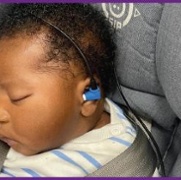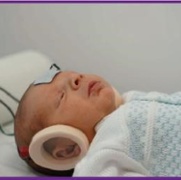The Screen
One or two babies in every 1000 are born with a hearing loss. Most of these babies will be born into families where no-one else has a hearing loss. Finding out early is important for your baby's development. This means you can get more support and information to help you and your baby.
Hearing screening tells us which babies may have a hearing loss. The screening test shows us which babies need more tests to decide if they have a hearing loss.
Screening does not detect all hearing loss or prevent future hearing difficulties.
Taking part in screening is something you can do to look after your baby’s health.
This animation gives information on the hearing screening test that you will be offered for your baby once they are born.
There are two types of tests.
 A small soft-tipped earpiece is put in the outer part of your baby's ear. This makes a clicking sound. The equipment shows the screener how your baby's ears are responding to the sound. This test is called and Automated Otoacoustic Emission (AOAE).
A small soft-tipped earpiece is put in the outer part of your baby's ear. This makes a clicking sound. The equipment shows the screener how your baby's ears are responding to the sound. This test is called and Automated Otoacoustic Emission (AOAE).
 If the equipment does not pick up a clear response, the screener may do a different test. Three small sticky pads are put on your baby's head and neck. Small headphones are put over your baby's ears, which will make a clicking sound. The equipment shows the screener how your baby's ears are responding to the sound. This test is called an Automated Auditory Brainstem Response (AABR).
If the equipment does not pick up a clear response, the screener may do a different test. Three small sticky pads are put on your baby's head and neck. Small headphones are put over your baby's ears, which will make a clicking sound. The equipment shows the screener how your baby's ears are responding to the sound. This test is called an Automated Auditory Brainstem Response (AABR).
Over 70% of babies will be tested in the first week of life or as soon as possible after that. We aim to screen most babies by 4 weeks of age. This may not be the case if your baby is born early or is unwell and needs Special Care. In this case the screener will explain to you the best time to screen your baby.
We try to screen as many babies as possible in the hospital so we hope to offer the test before you go home. If the test is not done in hospital, it will be offered in the community, usually at a local clinic. It is really important that you let us know if you will not be attending as we might be able to offer this appointment to someone else.
It is helpful if you take baby's seat, buggy or pram to this appointment. Your baby needs to be settled or asleep for the screening test so it helps if baby has just been fed. Written consent for the test is taken by the screener, so if this is your baby’s first screening appointment, someone with parental responsibility needs to bring baby. The 'Parental Responsibility checklist' sent with your clinic appointment letter tells you who has parental responsibility.
A screener will carry out the test. The screening test is done while your baby is settles or asleep. It will not hurt or harm your baby and only takes a few minutes. You can stay with your baby while the test is done.
Healthcare staff follow infection and prevention control guidance. This means they follow strict hand cleaning routines and clean all clinic areas and equipment regularly.
Remember, to stop the spread of infection, do not attend for screening if you are unwell.
Contact us if you have any questions or concerns about your baby’s screening appointment, or need an interpreter to support you during the appointment.
There are three possible results:
Clear response:
Most babies have a clear response from one or both of their ears. This means your baby is unlikely to have a hearing loss. The screener will give you information on how babies respond to sound as they grow. They will tell you what to do if you are worried about your baby's hearing.
If only one of your baby's ears shows a clear response:
Some babies show a clear response only in one ear. If this happens you may choose to have another hearing test. The screener will give you more information.
If neither of your baby's ears show a clear response:
Some babies do not show a clear response in either of their ears. It does not always mean your baby has a hearing loss.
The screener will offer you another hearing test for your baby. They will give you more information about what happens next.
Clear responses may not be seen if:
- Your baby is unsettled;
- There is fluid in the ear (from the birth);
- There is too much noise near the baby when the test is done; or
- Your baby has a hearing loss.
If more tests are needed an audiologist (hearing specialist) will send an appointment. This will be sent within four weeks from when you had your baby's hearing screening result.
Babies who have had special care for more than two days
If there is a clear response from both of your baby's ears it is unlikely that your baby has a hearing loss that will affect speech and language development. No further hearing screening tests are needed. The screener will give you information on how babies respond to sound as they grow and what to do if you have any worries about your baby's hearing.

The screener will tell you the result of the test straight away, and explain if another test is needed.
About 1 or 2 in every 100 babies will need tests with an audiologist after the screening test. These tests need to be done when a baby is still likely to sleep a lot during the day and you will be sent an appointment for the test within 4 weeks of your baby's hearing screening test. If your baby spent time in the special care baby unit (SCBU) this appointment will be sent within 8 weeks. Babies who are born early will be tested after the date they were due to be born. This allows time for your baby's hearing to develop.
For more information on the hearing assessment appointment click here, or you can read our leaflet Your Baby's Visit to the Audiology Clinic.
Out of 1,000 babies born, 1 or 2 will have a hearing loss in both ears.
Most of these babies will be born in to families where no one else has a hearing loss. A smaller number are born with a hearing loss in one hear. A baby who needed special care may be more likely to have a hearing loss. For every 10 babies who have this hearing test, one will have a permanent hearing loss.
Babies who have a clear response on the newborn hearing screen will not usually need to have further hearing tests, but these may be recommended by a Doctor. A hearing test is offered for all children in Wales in the year that they start school.
It is important to check your baby’s hearing as he or she grows. The checklist for parents helps you look for and listen to your baby’s responses. The checklist may also be found in your baby’s red book.
If you have concerns about your baby/child’s hearing, or listening responses, at any time speak to your Health Visitor or GP who can refer your baby/child to your local Audiology Department.
Click here for our Hearing Checklist for parents and carers.
If you would like more information or want to talk to someone about your baby's hearing please phone:
North Wales 03000 848710
South West Wales 01792 343364
South East Wales 02921 843568
Or if you'd prefer, our email address is newborn-hearing-screening@wales.nhs.uk
Discover more